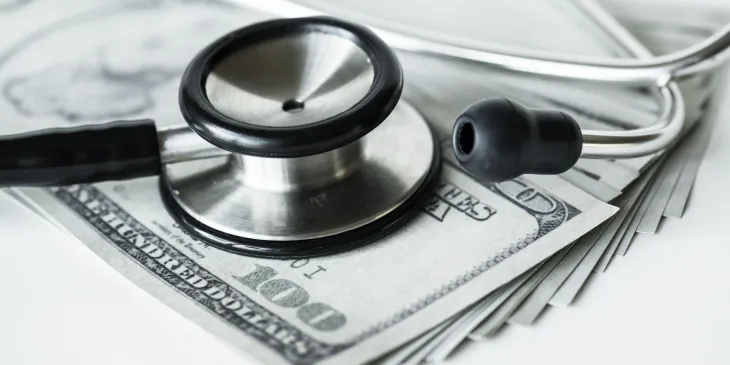6 Tips for How to Pay for a Major Medical Expense

This year, the Susan G. Komen Foundation predicts there will be 287,850 new cases of invasive breast cancer in women and 2,710 new cases of male breast cancer. While early detection and prevention are essential, cancer care and treatment costs can be astronomical. So how do you pay for these and other major medical expenses?
The overall cost of cancer care ranges considerably and can cost several thousands of dollars to well over $1 million. However, this price tag can be much higher or lower depending on your situation and needs.
If you have received a critical illness diagnosis, like cancer, it's natural to wonder how to pay for your treatment. After all, very few people are financially prepared to cover these astronomical expenses.
We've scoured the resources to bring you six tips to help you find the funds you need to cover a significant medical expense when you are sick.
Check Your Insurance Coverage
Most people have medical insurance, which is good news when facing expensive medical treatments. There was a time when insurance companies could deny coverage because of pre-existing medical conditions, but that's no longer true. However, each medical insurance policy differs in what the policy's out-of-pocket expenses look like, including co-pays for medical visits, coinsurance for prescription medications, and deductibles. So, check your policy provisions and ask your insurance provider to clarify any concerns.
Ask for Help From Family and Friends
Another option to pool the money for your medical expenses is to reach out to your loved ones. Many people are happy and willing to help contribute to a family or friend in need, whether offering financial support, helping with childcare, running errands, helping tidy your home, or cooking a meal.
Use Your Employer's Benefits
If you have a major medical event, such as a significant illness, and need to take time off work, check with your employer about their leave policies. Some companies offer paid medical leave or short-term and long-term disability benefits, which can help you financially while out of work.
You may qualify for the Family Medical Leave Act if you've worked for your employer for at least a year and have accrued 1,250 hours of service in the past year. If you're eligible, then FMLA protects your job, not your pay, for up to 12 weeks if a significant illness or injury causes you to miss work.
Fundraise
Fundraising efforts can include many ways to raise the money you need for medical treatment. You can have a bake sale, organize a car wash, or hold a charity event.
Many online platforms now offer ways for you to collect donations from friends and family nearby and across the world. Crowdfunding platforms have recently become increasingly popular for raising money for major medical expenses. Sites like GoFundMe and YouCaring offer the ability to create a personal fundraising campaign to solicit donations from family, friends, and even strangers.
Benefits are another popular choice to raise money for major medical expenses. These events get the community involved and might include multiple fundraising efforts at one event, such as:
- Concert
- Bake sale
- Silent auction
- T-shirt or bracelet sales
- Barbecues
You may also approach local businesses for sponsorships or in-kind donations.
Apply for Medical Assistance
Medical assistance programs help you pay for medical treatment if you're a low-income earner. Your eligibility for these funds depends on your income, family size, and the state in which you live.
Contact your state's Medicaid office or visit Healthcare.gov to learn more about these programs.
Use a Cash-Out Refinance
Do you own your home? If you have enough equity, a cash-out refinance might be another option for the funds needed to cover hefty medical expenses.
A cash-out refinance is when you take out a new loan to replace your current home loan and get cash at closing. Your lender calculates the payout based on the equity in your home. You can refinance up to 80% of your home's value, but you must keep at least 20% equity in your home after the refinance for most cash-out refinances.
This option can be beneficial if you have a lot of equity in your home, but it can come with some risks. When you refinance your home, you're taking on a new loan with new terms, which might include a higher interest rate and larger monthly payments. Also, if you don't make your monthly refinance payments, you could face foreclosure on your home. So, it would be best if you only used a cash-out refinance as a last option to cover major medical expenses.
Conclusion
When the cost of necessary medical treatment skyrockets, it's easy to get scared and stressed over how to cover these costs, but options are available. By exploring your options, you can make the best decision on how to pay for medical treatments without jeopardizing your financial future.
Sources
- https://www.komen.org/breast-cancer/facts-statistics/breast-cancer-statistics/
- https://www.aarp.org/money/credit-loans-debt/info-2018/the-high-cost-of-cancer-treatment.html
- https://www.verywellhealth.com/planning-a-fundraiser-for-someone-with-cancer-2249276
- https://www.hhs.gov/healthcare/about-the-aca/pre-existing-conditions/index.html
- https://www.cancer.org/treatment/finding-and-paying-for-treatment/health-insurance-laws/the-health-care-law.html
- https://www.fightcancer.org/policy-resources/out-pocket-spending-limits-are-crucial-cancer-patients-survivors
- https://www.cancercare.org/publications/300-coping_with_cancer_when_you_re_uninsured
- https://www.dol.gov/sites/dolgov/files/WHD/legacy/files/fmlaen.pdf
- https://www.cancer.org/treatment/finding-and-paying-for-treatment/health-insurance-laws/the-health-care-law.html
- https://www.foxbusiness.com/personal-finance/how-much-cash-out-refinance#how-much-can-you-get-with-cash-out-refi
- https://www.pharmacytimes.com/view/study-finds-total-cost-of-care-for-car-t-post-treatment-events-can-exceed-1-million
- https://aacrjournals.org/cebp/article/29/7/1304/72361/Medical-Care-Costs-Associated-with-Cancer



